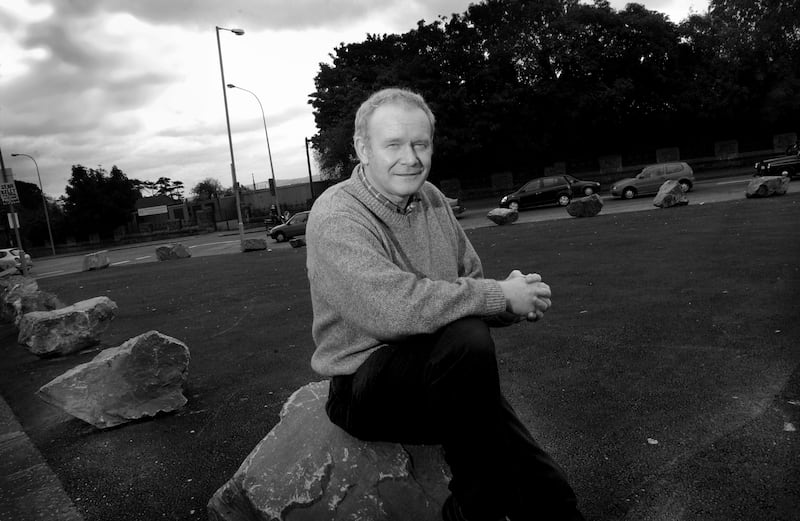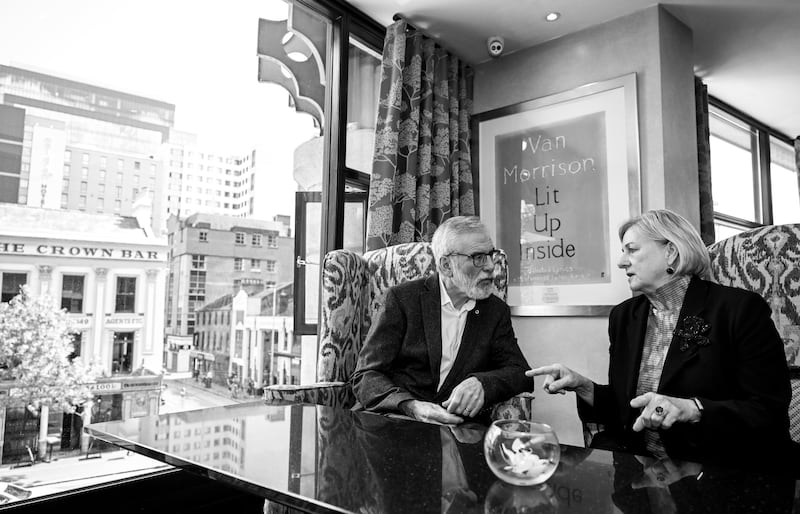A button is pressed, and the wheels on the old cassette tape start to turn. The crackle and hiss of a 30-year-old recording fill the hall in Derry’s Bogside; the audience is back in 1994, reliving the tensions of that time.
“That moment in the 1990s when this place thought about ceasefires and about peace and about how to say it,” is how author and journalist Brian Rowan describes it.
On August 31st, the IRA announced a ceasefire, a key turning point in the road towards what would become the Belfast Agreement and the transition to peace in Northern Ireland.
As the BBC’s security correspondent, Rowan was at the heart of the story; to mark its 30th anniversary, he has written a book, Impossible Peace, which combines those old interviews and his personal document archive with new writing on the ceasefire and peace process.
Trump urged to appoint NI special envoy to support US interests after Kennedy departure
‘It’s about women North and South learning about each other, learning about the grassroots issues in their communities’
Alan Gilsenan: ‘I would have had a dreamy, artsy-fartsy notion that a united Ireland would be great’
“It is history on tape and on paper,” he writes, “about a hard-won peace and about all of the nervousness in those events of 30 years ago.
“It is a marrying of spoken and written words that help tell the story of what the former Clinton adviser Nancy Soderberg describes as a ‘miracle’ emerging out of leadership and vision; that moment, to borrow a thought from Miriam Reynolds, daughter of the late Albert Reynolds, when an impossible peace began to look possible.”
The live show debuted at this month’s Féile an Phobail in Belfast and Féile Derry, and mixes a conversation led by Rowan with clips from the ageing tapes, some of which have never before been broadcast.
The voices of the dead speak again, while the living listen back to the words of their younger selves.
“I had been subjected to incredible attacks from sections of the media and politicians ... but I realised there was a real opportunity here to save human lives,” said the then SDLP leader, John Hume, of the Hume-Adams talks in an interview with Rowan in February 1995.
“So, what did John Hume and I do? After 25 years of conflict, we shattered the illusion that this was intractable,” said the then Sinn Féin leader, Gerry Adams, in March 1995.
There was also a secret backchannel, three Derrymen – Denis Bradley, Brendan Duddy and Noel Gallagher – who were the “links in the chain” between the republican leadership and the British government.

“A lot of this was interpreting [Martin] McGuinness’s mind,” said Bradley in an interview from March 2000, of the former IRA chief of staff who would become Sinn Féin’s chief negotiator “You’re no good as a mediator if all you do is mediate.”
In November 1993, the then northern secretary, Patrick Mayhew, would suggest that a “remarkable” set of words had been sent earlier that year through that backchannel, words he attributed to McGuinness and the republican leadership, “to the effect that the conflict was over, but they needed our advice as to the means of bringing it to a close”.
They had in fact been written by Bradley; in his essay, he writes of the significance of another message, or what were “called comms in the jails. Tightly-wrapped pieces of paper containing a written message, smuggled in or out of the prisons but also used in contacts between various branches of the IRA.
“On a May night in 1993, McGuinness was in the same room in Derry where, just a few weeks previously, he and Gerry Kelly had met with a British government representative, code-named Fred.”
Bradley describes watching McGuinness “taking comms from various parts of his clothing” and delivering a message to the three men “that the IRA would agree a two-week ceasefire to allow for talks ... the statement was revealing that the republican leadership was willing to break through the psychological barrier of committing to a ceasefire, before negotiations would take place.
“It was clear to those of us present that a major opportunity for peace had just opened up.”
But, writes Bradley, the UK government “was not yet ready to cross its Rubicon.
“In the following weeks the backchannel members opted to bring their intermediary role to an end by fully informing the Irish government and John Hume of the longevity and substantiveness of the backchannel, and most specifically of the request and the granting of a two weeks ceasefire to allow for beginning talks.
“In the following months of claims and counterclaims, it was probably that information in the hands of influential and capable politicians that made it inevitable that the British government would join the others on the southern side of the Rubicon.”
Soderberg, then the White House deputy national security adviser, writes about another step on the path towards the ceasefire, the granting of a US visa for Adams.
She made the argument to the then US president, Bill Clinton, that it was “a win either way. If it helped foster a ceasefire, then Clinton’s actions would be vindicated. If Adams failed to deliver a ceasefire after Clinton had risked such political capital on him, then Clinton would be in a strong position to turn Irish-America against Adams, rein in US support for the IRA and weaken it.”

The visa was granted. “Adams had a triumphant visit to New York …‘But where was the ceasefire?’ we kept asking.”
They waited and waited. “By August [1994] I had given up. I began to think of ways we could squeeze the IRA’s supporters in the US and dry up fundraising.”
Later that month, she was on holiday when she received a phone call from the then US ambassador in Dublin, Jean Kennedy Smith. “’We have to give a visa to Joe Cahill,’ Jean said emphatically.
Soderberg said: “‘What? Are you insane? No, I’m not even putting that request in. We aren’t doing any more visas without a ceasefire,’ I replied.”
A few days later, came the same question. “’Jean, show me the ceasefire, then we’ll talk,’ I insisted, really fed up by now.
“A few minutes later, to my surprise, the taoiseach, Albert Reynolds, was on the phone. ‘You have to give Joe Cahill a visa,’ he said emphatically. “Cahill is the only one that can convince the hard line in the US to support the ceasefire,’ he calmly explained.
“Then he read me the planned IRA ceasefire statement. I was stunned. It was a clear and unequivocal statement – unlike the usual mishmash and caveated statements issued by the IRA.
“Cahill had his visa. It was clear history was about to be made,” writes Soderberg.
On August 30th, 1994, Rowan was on standby for a ceasefire announcement; he “paced the floors of the BBC for hours waiting on a call ... but my phone didn’t ring, not until the following morning.”
The hours of delay, he later learned, had been over the battle for Cahill’s visa.
“Something I would learn about many months later: how Fr [Alec] Reid persuaded Reynolds, and how Reynolds persuaded the president. This was the influence of the taoiseach of 1994. The risk-taker.” (Reid was pivotal to the beginnings of the Northern Ireland peace process).
Reynolds’s daughter Miriam writes of her late father’s efforts for peace and their impact on the family; of Fr Reid calling to the house in person at 3am, “often carrying ‘A Chara’ correspondence”, and of a handwritten letter from Archbishop Robin Eames that contained “consent wording”.
“Unbeknownst to the Government and the gardaí, [my sister] Cathy drove Dad to a covert meeting with [former UVF leader] Gusty Spence and [Progressive Unionist Party leader] David Ervine at the Berkeley Court Hotel.”
There was the letter from the former UK prime minister, John Major, after her mother Kathleen’s death. “As soon as your Dad and I finished our political chat, we talked often about our families and his delight in Kathleen and all his family shone through everything he said: he thought that he was a lucky man – and he was!”
His sons and daughters “backed him. But did we believe him when he said he’d deliver peace? Dad was a great man for the unthinkable. But he valued odds and evidence. The real-time evidence was ominous.
“Calls came in from Washington and the White House ... we were invited to the White House on March 17th, 1994 ... one of us tried on the president’s bulletproof coat.”
[ Martin Mansergh: John Hume ensured the emancipation of Catholics in the NorthOpens in new window ]
Among the many callers to the Reynolds home was his key adviser, Dr Martin Mansergh. “He recalls one of the most memorable being towards the end of August 1994. Dad had the draft IRA ceasefire statement.
“They discussed it at length. Martin recalls: ‘While not perfect, he was happy to run with it.”
[ Brian Rowan: ‘I know what is meant by a new level of horror’Opens in new window ]
Today, Reynolds grandchildren “are proud, loving and loyal fans. They and their children will witness the assessment of Dad’s contribution to history as time passes.”
Impossible Peace by Brian Rowan, designed by Ciaran Hurson, is available at the Open University’s OpenLearn site
- Sign up for push alerts and have the best news, analysis and comment delivered directly to your phone
- Join The Irish Times on WhatsApp and stay up to date
- Listen to our Inside Politics podcast for the best political chat and analysis



















